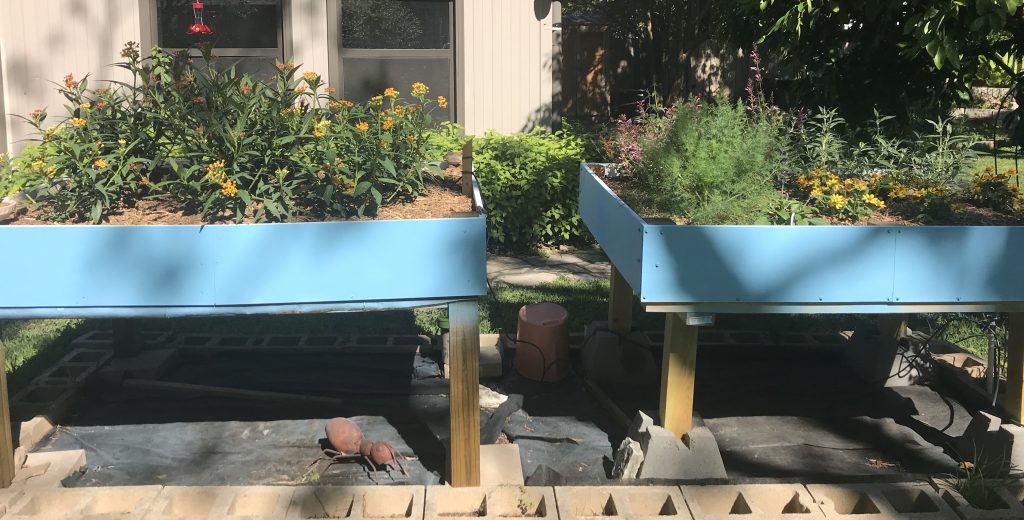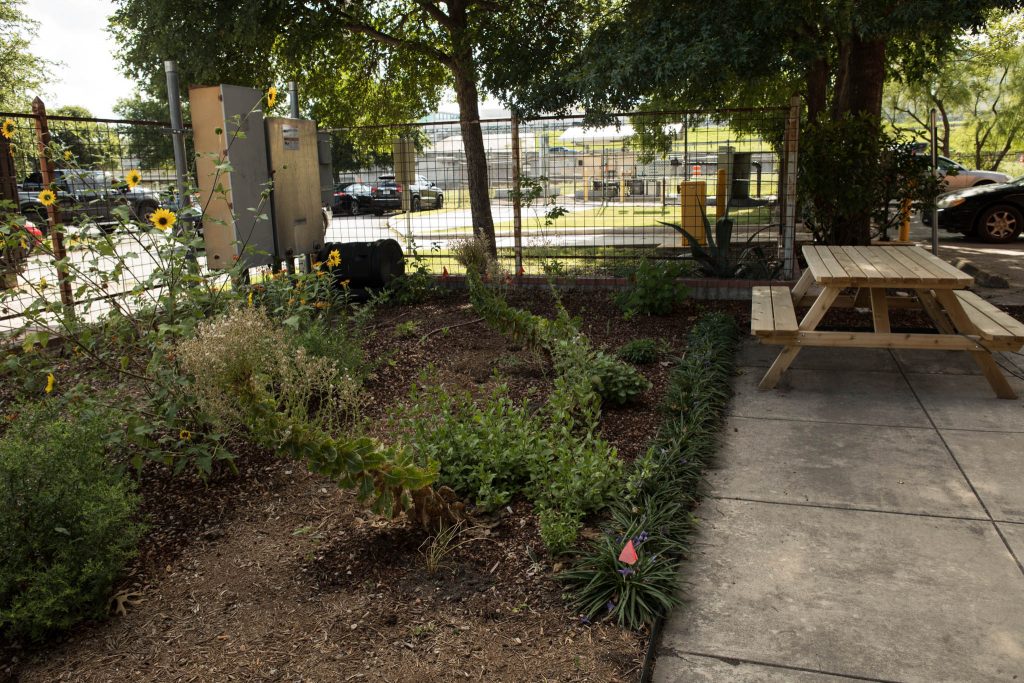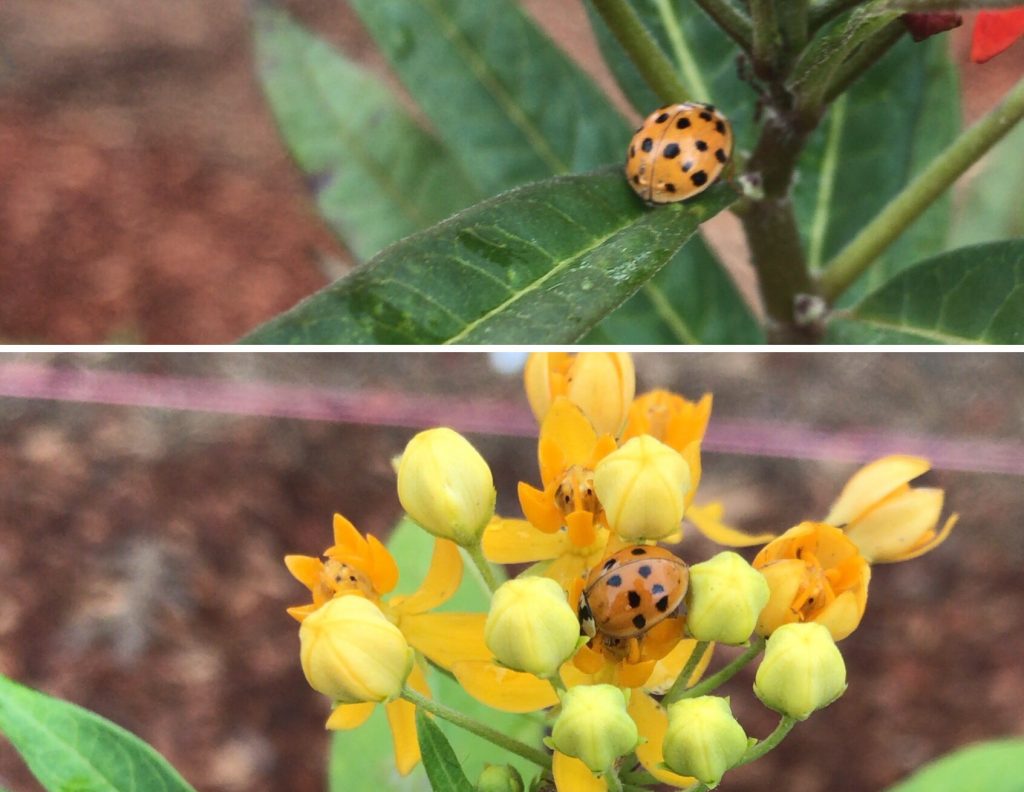It’s been a little more than a year since we launched our 300for300 Pollinator Habitat Challenge, a community initiative to encourage pollinator friendly landscaping in San Antonio.

Mary Kay Steward’s raised pollinator gardens, built by her husband. On left, milkweed garden. On right, nectar plants. Photo courtesy Mary Kay Stewart
In March of 2018, we set out to create 300 pollinator gardens for San Antonio’s Tricentennial birthday. By December 31, we had exceeded our goal, with 324 habitats pledged.
The effort resulted from San Antonio’s status as the first Monarch Butterfly Champion City in the country. In December of 2015, San Antonio became the first city in the nation to agree to act on all 24 recommendations made by the National Wildlife Federation to increase urban pollinator habitat as part of the Mayor’s Monarch Pledge. A citywide pollinator gardening initiative was among the action items pledged.
As of June 2019, 370 pollinator gardens have registered for the challenge. Like the bees and butterflies that inspired it, 300for300 has moved beyond San Antonio with pledges from Round Rock, Laredo, California and beyond.
People like Mary Kay Stewart and Ryan Martinez pledged and planted a mix of spring bloomers, fall flowers, host plants and nectar sources. Pesticides were not welcomed, but bees, butterflies, birds and other wildlife have an open invitation.
Stewart had undergone spinal surgery in 2014 and has a hard time bending over. That didn’t stop her from participating, however.
“I really haven’t been the same since,” she said via email, adding that her husband helped her build elevated beds on stilts. “I adore my raised gardens and it’s so easy to peek under leaves for monarch eggs/caterpillars!”
Martinez, who splits his time between Laredo and San Antonio, installed pollinator gardens in both cities.
He mentioned a common challenge for pollinator gardeners: acceptance of the sometimes “messy” habitat by those with a limited view of what constitutes beauty.
“I, as well as others who have started butterfly gardening… have had our early growth chopped down,” said Martinez. The Laredo garden in particular faced resistance. “I put up a sign in English and Spanish informing them that it is a butterfly/wildflower garden and they are not to mow. As you know, it is crushing when your work is chopped down by a gardener.”

San Antonio news organization, the Rivard Report, installed a pollinator garden behind their office as part of 300for300. The picnic stable is a popular spot for staff to take a breatk. Photo by Bonnie Arbittier
Those with a certain aesthetic sometimes feel compelled to unleash weedwhackers and lawnmowers to seed-sowing pollinator habitats to “clean things up.” Yet, if flowering annuals are denied the chance to sow next year’s flower crop by going to seed, much of the investment in a pollinator habitat is wasted.
Businesses also participated in 300for300. Our friends at the Rivard Report, with assistance from Greenhaven Landscaping, took a Bermuda grass riddled plot behind their office near San Antonio’s Alamodome and gave it a makeover as a pollinator habitat.
Milkweeds, sages, Crawford lettuce (a self sowing native annual that also happens to make a great salad), Cowpen daisy and other nectar and host plants now populate the full sun yard.

Ladybugs join Rivard Report staff in the news organization’s 300for300 garden near the Alamodome downtown. Photo by Laura Lopez
Laura Lopez, events and audience engagement coordinator for the award-winning local news website, shared photos earlier this year of monarch caterpillars and ladybugs making themselves at home. “It’s neat watching everything grow after all the rain we’ve had,” she said.
Lopez said the space serves double duty as a retreat for pollinators and the Rivard Report team. “You can visibly see people’s shoulders relax when they step foot in the garden. ” she said. She’s taken several caterpillars home to share with her two sons, who’ve enjoyed watching them morph through their stages.
The San Antonio and greater community did such a great job of reaching the initial 300for300 goal, it’s hard not to wonder: should we continue the pollinator habitat initiative? How about 500 pollinator habitats by the end of 2019?
Rebeca Quiñonez Piñón, monarch outreach coordinator for the NWF, thinks that’s doable.
“San Antonio residents are passionate conservationists, and I have no doubt that they will reach their new challenge to add 200 more monarch gardens to their initial goal of 300,” said Quiñonez- Piñón. She added that recent studies indicate thath all pollinators benefit from native gardens in urban settings. “San Antonio has learned when it comes to pollinator gardens, more are better.”
What do you think? Please let us know by casting a vote at this link:
Should we extend 300for300? 500 pollinator habitats by 2020?
We’ll report results. If you all are up for it, we’ll set a new goal of 500 pollinator habitats by year’s end.
For those interested in creating a pollinator habitat, check out our resources:
Sign up for the pollinator habitat challenge.
Plant lists and other pollinator gardening resources.
Pollinator habitat signs are available in our shop.
TOP PHOTO: Ryan Martinez of San Antonio planted this pollinator habitat as part of our 300for300 initiative. Photo by Ryan Martinez
Related posts:
- Popularity of pollinator gardens growing in areas prone to drought
- Planting a butterfly garden? Here’s tips on how to do it
- Mostly native butterfly garden outperforms lawn every time
- A year in the life of an urban butterfly garden
- Downtown River walk plot converts to pollinator garden, creature haven
- Converting your Lawn to a Butterfly Garden
- San Antonio becomes first National Wildlife Federation Monarch Champion city
- Tropical Milkweed: To Plant it or Not is No Simple Question
- How to raise Eastern Swallowtails
- How to raise Monarch butterflies at home
Like what you’re reading? Don’t miss a single post from the Texas Butterfly Ranch. Sign up for email delivery at the very bottom of this page, like us on Facebook, or follow us on Twitter, @monikam.


My friends and I have been raising monarchs for several years. Cheryl Alexander is one of your pollinator gardens (think I have that right). Anyway, she and her neighbors are having loads of luck with larvae. In the past, I have had great success. But now….ME? I have flourishing milkweed and not one single chew. No eggs. No larvae, But the butterflies and the bees are still there on the nectar plants. Could it be the lizards and wasps feeding on the eggs and larvae?
My HOA does spray for mosquitos but a friend who used to be in charge of that division of Harris County Public Health says the spray barely makes it into the yards, and for sure not in the back yards. I wonder….
Any way, any advice?
Most monarchs should have moved to the summer breeding grounds in the Midwest and Northeast by now Jane, however, queen butterflies look a lot like monarchs and are a local non migrating species I’ve raised a lot of in central Texas during the summer. The caterpillars eat milkweed just like monarchs and the adults love Gregg’s mist to nectar on. You should be seeing queens in your garden soon and if you can net one or find some eggs on your tropical milkweed you can raise them using the following procedure linked here. http://Www.HowtoRaiseMonarchButterflies.com. Just click on the orange tab and watch the videos. Enthusiasts could concentrate on this Species during the summer in San Antonio so all the beautiful pollinator gardens being planted will have more butterflies in them.
I hatched 21 Monarchs in the spring. The most I have ever done. I do hope to come jto San Antonio in Oct. and would like some info on the event.
Not many tropical milkweeds came back from last year, but have plenty of native butterfly weeds all around my five acres property. I have planted more seeds for swamp milkweed, antelope milkweed and other two other types that are coming up now. Hopefully we will see Monarchs soon. Your group is in and around San Antonio. Any group in Fort Worth that I can hook up with?
I’m in Rocky Ford, CO.. I’m trying to create a butterfly, hummingbird habitat here on my little farm.. I get confused we are classified as zone 5b but more like Zone 4.. every 3rd year we get 20 30 below.. what are some plants I can place here for a butterfly hatchery? A hummingbird nesting site? I get so confused.